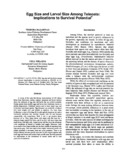Egg size and larval size among teleosts: implications to survival potential
- Global styles
- MLA
- Vancouver
- Elsevier - Harvard
- APA
- Help
Share
Abstract
A survey of the early life history characteristics of 135 teleost fishes from freshwater, marine, tropical, temperate and boreal habitats show the influence of egg size and larval size on survival potential. Marine species have smaller eggs and larvae than freshwater species at similar temperatures. Coldwater species tend to have larger eggs and larvae than warm water species. Egg diameters are positively correlated with larval lengths (Lh) and weights at hatching. The times from fertilization to onset of feeding (tf), to yolk and oil resorption (ty) and to irreversible starvation (ts), increase linearly with Lh and decrease exponentially with temperature. Both tf and ts are positive linear functions of ty. Thus, larger larvae with much yolk that lasts for a relatively longer period feed later and if not fed, will starve later than small larvae with little yolk. Larger larvae will thus have the advantage under conditions of limited or variable food supply. Moreover, large larvae tend to have large mouths and are thus capable of ingesting large high-calorie prey. They also tend to have higher swimming speeds and greater potential to encounter food and avoid predators. There is no definite relation between growth rates and Lh, but tropical species with small eggs and larvae tend to have high growth rates. Survival potential has implications in the recruitment to natural stocks and in seed production in hatcheries.
Type
Conference paperISBN
971102227Collections
- Conference Proceedings [299]
Related items
Showing items related by title, author, creator and subject.
-
Size measurement and nutritional condition evaluation methods in sandfish (Holothuria scabra Jaeger)
Watanabe, Satoshi; Zarate, Jacques M.; Sumbing, Joemel Gentelizo; Lebata-Ramos, Maria Junemie Hazel ; Nievales, Marie Frances (Wiley, 2012)
The aims of this study were to establish an accurate size measurement method and a nutritional condition evaluation method of Holothuria scabra (Jaeger). Although 0.5% KCl and 0.05% MgSO4 did not induce anaesthesia, ...
; Nievales, Marie Frances (Wiley, 2012)
The aims of this study were to establish an accurate size measurement method and a nutritional condition evaluation method of Holothuria scabra (Jaeger). Although 0.5% KCl and 0.05% MgSO4 did not induce anaesthesia, ... -
Growth pattern of the tropical sea cucumber, Holothuria scabra, under captivity
Watanabe, Satoshi; Sumbing, Joemel; Lebata-Ramos, Ma. Junemie Hazel (Ministry of Tropical Agricultural Research Centre, 2014)
The growth of the juvenile sea cucumber, Holothuria scabra, was studied under captivity to elucidate the growth variation pattern and determine the best-fit growth model to estimate age- and size-specific growth rates. ...
(Ministry of Tropical Agricultural Research Centre, 2014)
The growth of the juvenile sea cucumber, Holothuria scabra, was studied under captivity to elucidate the growth variation pattern and determine the best-fit growth model to estimate age- and size-specific growth rates. ... -
Diet composition, feed preferences and mouth morphology of early stage silver therapon (Leiopotherapon plumbeus, Kner 1864) larvae reared in outdoor tanks
This study examined the diet composition, feeding preferences, and mouth morphology of the silver therapon (Leiopotherapon plumbeus, Kner 1864) larvae under captive conditions. Larvae were reared in outdoor tanks (4 ...





